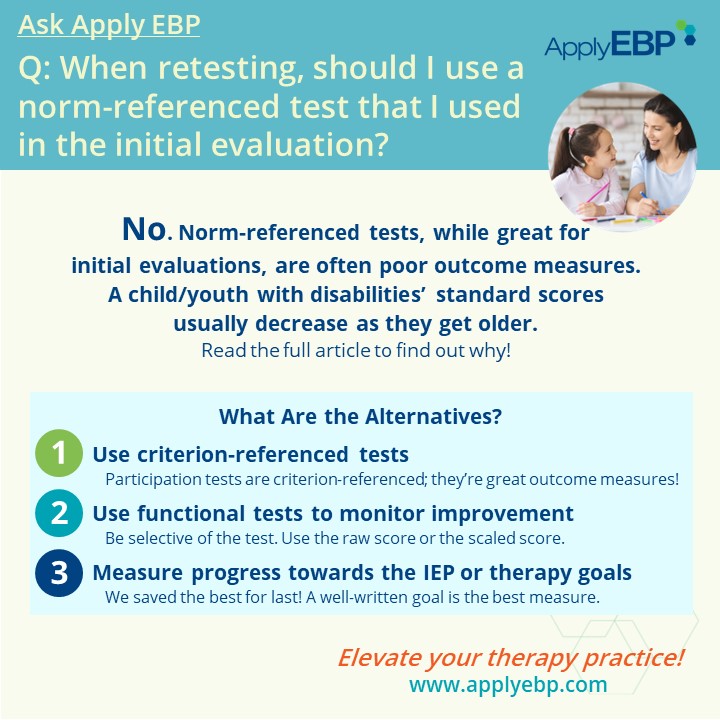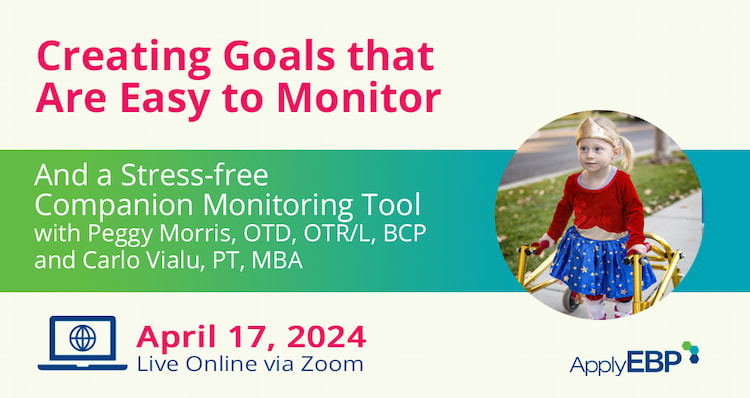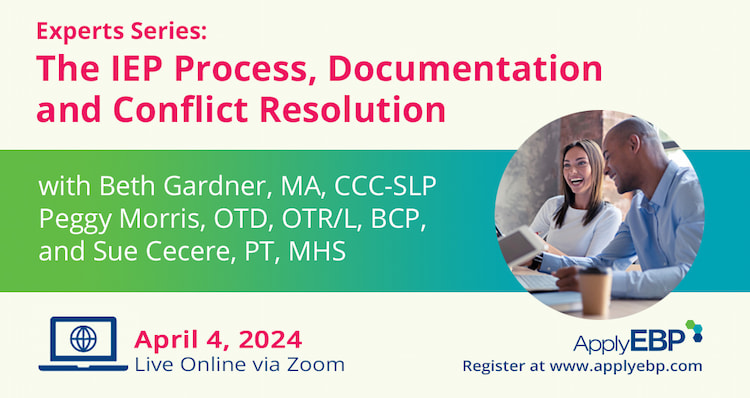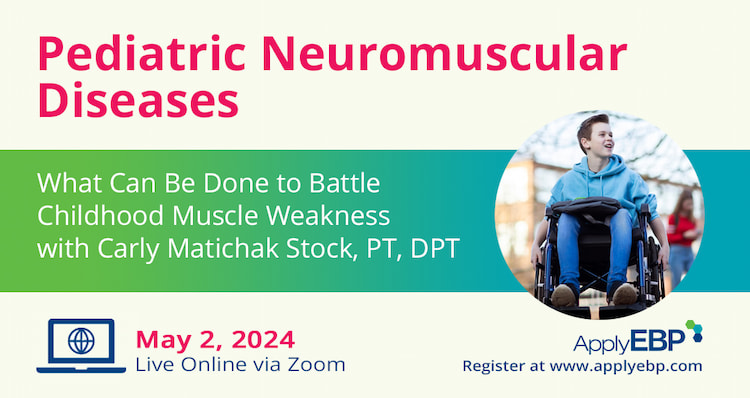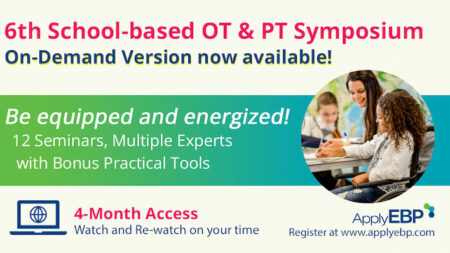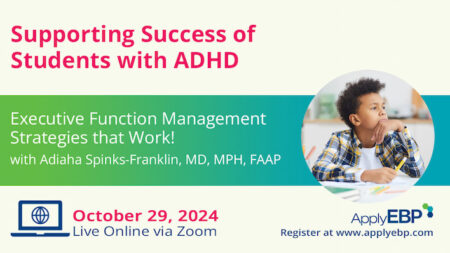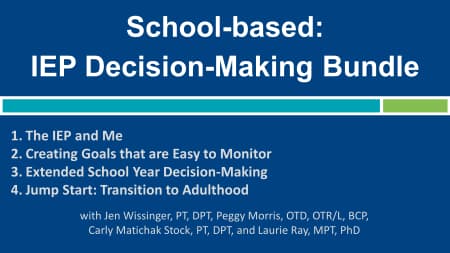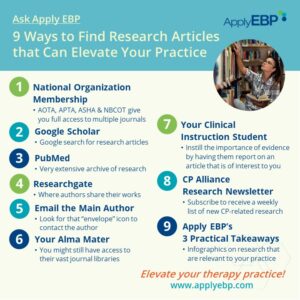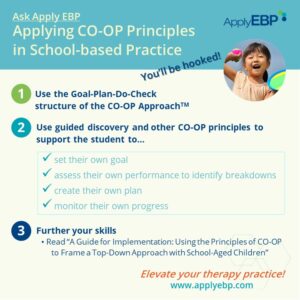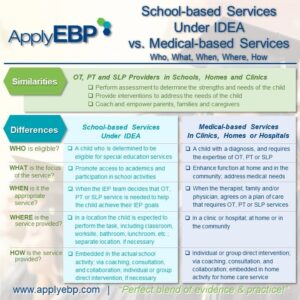Ask Apply EBP
Why Norm-referenced Tests Are Poor Outcome Measures…and Better Options
Q: When retesting, should I use a norm-referenced test that I used in the initial evaluation?
A: The short answer is no. You do not need to re-administer all the tests you used in the initial evaluation. You will need to be selective. Norm-referenced tests, while great for initial evaluations, are often poor outcome measures.
Uses of Norm-referenced Tests
Is it time for you to retest the child/youth and report on their progress? You might be wondering what tests to use, or whether you should re-administer all the tests you utilized in the initial evaluation, including norm-referenced tests.
As mentioned in the short answer above, norm-referenced tests are poor outcome measures. But before delving into the negatives, let’s start with the positives of norm-referenced tests. Norm-referenced tests are great for the following purposes:
-
- For comparing a client’s performance to their peers or representative group. This is helpful in an initial evaluation to help you discriminate between children who are showing a delay and may need your services, from children who are performing similarly to their peers, and hence, may not need your services.
- For pinpointing possible contributing factors to participation restrictions. For example, if a client is having difficulty participating in Physical Education, using the Movement-ABC may help pinpoint if the child’s coordination is a possible contributing factor.
- When achieving “normal” performance is the goal, for example, in acute non-long-term injuries, such as an ankle sprain or a fracture in the upper extremity that causes a temporary decrease in function.
- In a few cases, where reference data for tests were taken for specific populations over time, such that you may use the tests against a developmental trajectory. For example, the tests used in CanChild’s On Track study have developmental trajectories for children with Cerebral Palsy from 1.5 to 12 years of age. They can therefore be used to compare performance to their “similar” peers.
- For certain diagnoses, where monitoring of change in test performance helps inform decision-making. For example, repeated use of the North Star Ambulatory Assessment can help predict when wheeled mobility may be needed for clients with Duchenne Muscular Dystrophy.
- In research, as a consistent tool to measure pre- and post-intervention performances, as well as for comparison between the experimental and control groups. However, norm-referenced tests are, in general, not great outcome measures in real life (i.e, outside of research)…
Why Norm-Referenced Tests Are Poor Real-Life Outcome Measures
You have probably noticed when retesting using a norm-referenced test, that the standard scores of your clients with disabilities decrease over time. This decrease is even more confusing and difficult to explain when you know that they are gaining more skills (e.g., the child cannot do item #30 before, and now they can do it easily, but their standard score is lower). Why is this happening?
-
-
- For many of our clients, their disabilities are lifelong. Their impairments are non-malleable, and may limit their ability to complete more challenging tasks that are expected of them as they get older.
- In the meantime, their normative peers with typical development are gaining skills at a faster rate than they are. Thus, the gap between their performance and their peers’ performance widens over time.
- Finally, many tests require a prescribed manner of performance to achieve the highest scores. Despite successful task completion, our clients with disabilities may still score low in such tests if they use an alternative manner of performance that takes advantage of their strengths.
-
All of these add up to standard scores that decrease over time for our clients with disabilities. Imagine reporting the child’s decreased standard score, even when you know that the child’s skills have actually improved!
So, What Are Better Alternatives?
Since norm-referenced tests are, in general, poor tools for capturing the improvement in our clients with disabilities, we give you these 3 better alternatives, in no particular order:
-
-
- Use Criterion-Referenced Tests
- These tests are designed to measure an individual’s performance against a given set of criteria. When retesting over time, a criterion-referenced test can show increases in test scores with improvements in performance on those given set of criteria.
- Examples of criterion-referenced tests: School Functional Assessment, Handwriting Legibility Scale, 6-Minute Push Test, and most participation tests (more on these tests in later posts)
- Use Functional Tests to Monitor Improvement in Performance
- Some norm-referenced tests focus on function and can be used as criterion-referenced tests.
- In this case, instead of using the available norms, you would use the raw score or the scaled score. For example,
- You can use the raw score (i.e., time in seconds) of the Timed Up and Go to compare current performance to previous performance
- You can use the scaled score of the PEDI-CAT over time, and ignore the age percentile and T-score
- Be very selective of tests to use in this manner.
- We re-emphasize the phrase “functional tests”, by which we mean tests that are typically at the Activity and/or Participation Levels of the International Classification of Function (ICF), and NOT tests at the Body Function and Structure Levels. For example, the BOT-2, Beery VMI, M-FUN, Sensory Profile, and WRAVMA are tests at the Body Level, and are not good functional tests.
- As mentioned above, many impairments at the Body Function and Structure Level are not malleable…they do not change over time, even with interventions. Therefore, there is no immediate need to re-measure them…these tests are often one-and-done.
- Measure the Progress towards the Child/Youth’s IEP or Therapy Goals
- We did save the best for last… IEP (in a school setting) or Therapy Goals (in other settings) are the best to use for monitoring progress as they are individualized to the child/youth. So report on these, instead of using standardized tests.
- Just make sure when creating the goal that it:
- Is easy to measure
- Addresses a real-life functional need of the child/youth
- Takes into account the potential of the child/youth for improvement
- You can also create a monitoring tool to accompany the goal that would help you decide whether the child/youth is on track on achieving their goal, or if there is a need to change the intervention or the goal. For more on this, join Creating Goals that Are Easy to Monitor.
- Use Criterion-Referenced Tests
-
My final suggestions are:
-
-
- Do share this information at your team meeting. Explain the reasoning for using certain tests and not others for retesting. In cases where you have to use a norm-referenced test, describe the purpose of the test and interpret results with caution.
- Celebrate your client’s strengths and improvement towards their IEP/therapy goals. The low score in a norm-referenced test does not necessarily preclude improvements in function. It just gave you an idea of their areas of strengths that needs to be magnified, and areas of challenges that need workarounds.
-
Also, join us for…
Find More Answers to Your Questions in Our...
Featured School
Symposium
6th Online School-based OT and PT Symposium - On-demand Version
- Watch and re-watch on your own time
- On-Demand Version
- OTs, OTAs, PTs and PTAs
- $399-449
Featured Live
Workshop
Supporting Success of Students with ADHD
- October 29, 2024, 8:30 am–3:30 pm Eastern Time
- Online via Zoom
Featured On-Demand
Webinar
Everything's Measurable! OT & PT Tests
Featured Webinar
Bundle
IEP Decision-Making Bundle
Have a question?
Submit here…
*Clicking submit will send your question directly to our email inbox. Your name and email will let us know that your submission is real (not spam). We will not include these in our posts, unless you tell us to include your name. Please read our privacy policy here.
All infographics and videos on www.applyebp.com are intellectual properties of Apply EBP, LLC
You may use the infographics and videos for free for any non-commercial, educational purposes. Please cite the source as “Apply EBP, LLC” and a link to the source article. If you plan to use any infographic or video for commercial purposes (i.e., for profit), please email Carlo@applyebp.com to obtain a written permission. Permission can be granted on a case-by-case basis.

